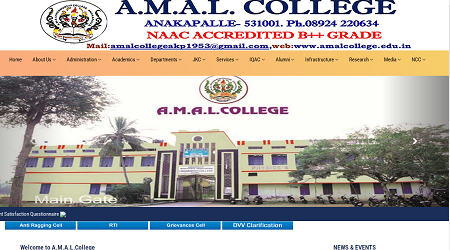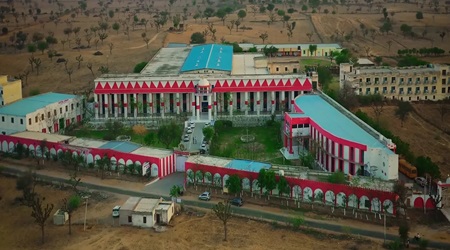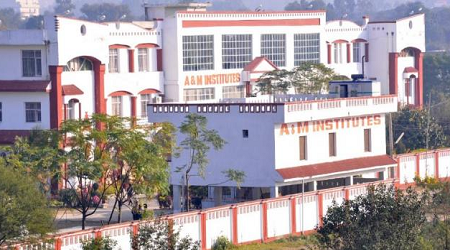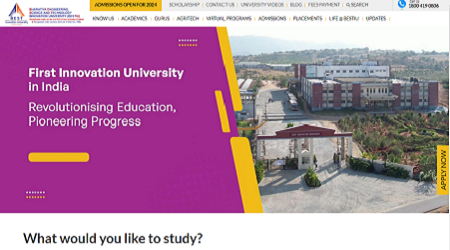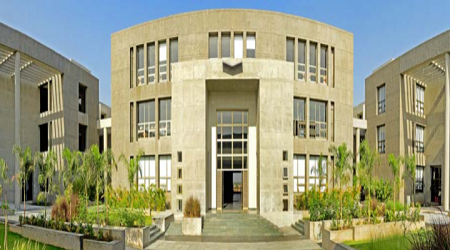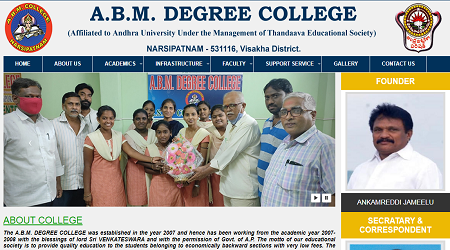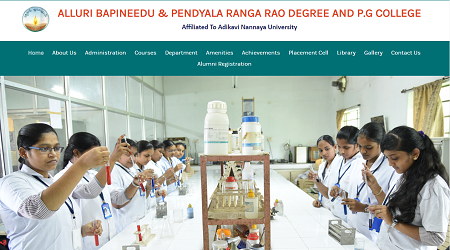Bachelor of Science in Radiography admission
Radiography is a paramedical education for students interested in performing diagnostic tests and medical treatments utilizing radiation technologies. The Bachelors of Science in Radiography (BSc Radiography) is a three-year program that is separated into semesters with about six semesters throughout the program. Radiography is a paramedical specialty that focuses on the treatment of disorders that affect the body’s internal organs. They employ X-rays as part of this therapy.
THREE_BUTTON
Experts in the discipline frequently operate in areas like Accident and Emergency, Operation Theatre, and so on. They’ve been taught to take X-rays, MRIs, and CT scans, among other things. Radiography is also utilized to treat cancer patients.

Course Highlights:
| Degree | Bachelor level |
| Full-Form | Bachelor of Science in Radiography |
| Duration | 3 years |
| Age Between | 17 – 25 years. |
| Eligibility | 10+2 with a minimum of 50% |
| Course Fees | INR 2000-10 lacs |
| Average Starting Salary | INR 7000-10,000 initially |
| Job Positions | X-Ray Technician, Physiotherapist, Radiation Protection Specialist, etc. |
Course Eligibility:
- Candidates must have completed a qualifying test, such as 10+2 or an equivalent degree from a recognised institution.
- Physics, Chemistry, and Mathematics must have been compulsory topics in their 10+2 education.
- When applying to institutions that require an entrance test, candidates must pass the college’s cutoff. Cut-offs, on the other hand, tend to change from year to year.
- Students must score well on their qualifying test in order to clear the merit at universities where admissions are dependent on merit.
- A minimum of 50% on the qualifying examination is required by several colleges.
- The selected candidates are required to attend the college’s own counselling sessions.
Admission Process:
The BSc Radiography Admissions Process is the same as it is for all other degrees. However, if you want to be accepted into the BSc Radiography program, there are a few things you should keep in mind. The following is the procedure for applying for the same:
- Admission to the BSc Radiography program is either entrance-based or merit-based, depending on the college.
- The applicant’s marks at their 10+2 level from a recognized institute are taken into account in merit-based selection.
- In most cases, the admissions process begins in the months of July and August. The admission tests take place between March and May.
- whether they satisfy the prerequisites for the same.
- Following their passing of the entrance tests, the admission procedure is followed by counseling sessions hosted by the college.
THREE_BUTTON
Entrance Exams:
Across the country, students seeking a B.Sc. in radiography are extremely motivated. Both national and state-level entrance tests are offered. Aspirants who have studied science topics in the past are qualified to sit for the admission tests and choose the best college for them.
The most common entrance examinations are listed below:
- AIEEE
- AICET
- IIT JEE
- JNU EEE

Entrance Exams Syllabus:
- The qualifying requirements for B.Sc Radiography admission examinations vary depending on the tests conducting body, and they range from question selections to exam patterns.
- In summary, the following are the common knowledge for hopefuls pursuing admission exams:
- The question is based entirely on science subjects such as biology, physics, and chemistry.
- Major science disciplines are intended to have objective-type questions.
- Depending on the conducting authority, the tests are either online or offline.
- The paper would be graded on a scale of one to ten.
How to Apply?
- The candidate must generate his or her own login ID and password.
- Go to the university’s official website and log in.
- Complete all relevant fields and submit all required papers.
- Pay the application fee through debit card, credit card, or net banking after uploading all needed papers.
- Select the’submit’ option.
- These are the steps that candidates must take, and they are generally the same at most universities.
Documents Requirement:
- Mark sheet and pass certificate of your Class X or XII examination.
- Proof of date of birth.
- School leaving certificate
- Transfer certificate
- Domicile certificate/ residential proof or certificate
- Provisional certificate
- Character certificate
- Scheduled Caste/ Scheduled Tribe/Other Backward Caste certificates
- Proof of disability (if any)
- Migration Certificate

Top College:
| All India Institute of Medical Science, Delhi |
| Rajiv Gandhi University of Health Science, Mumbai |
| University College of Medical Science and GTP Hospital, New Delhi |
| Tata Memorial Center, Mumbai |
| TRC Institute for Materials Technology, Mumbai |
| All India Institute of Medical Science, Delhi |
| University College of Medical Sciences and GTB Hospital |
| Rajiv Gandhi University of Health Sciences |
| Tata Memorial Centre Mumbai |
| Maharaja Agrasen Medical College |
Course Subjects:
Aspirants must complete secondary education with science topics and top-level biology and chemistry grades in order to get a B.Sc Radiography degree.
The following are the required topics and syllabus for a B.Sc. in Radiography:
- Radiography
- Fluoroscopy
- Special Radiography
- Modern Imaging Systems
- Nuclear Medicine
- Production of X-rays
- Interaction of Radiation with Matter
Future Course:
A BSc Radiography degree allows graduates to work in forensic laboratories, healthcare organisations, and hospitals, among other places. Aspirants can find jobs in higher positions using the expertise gained from higher education institutes.
The following are the finest course options for those interested in pursuing higher education:
- Diploma in Radio-diagnostic Technology
- MD Radio Diagnosis
- MS Radio Diagnosis
Future Job Scope:
Mentioned below are the jobs for B.Sc Radiography:
- Radiology Technician
- Radiologist
- MRI Technician
- Radiology Assistant
- Radiology Technologist
- Radiographer
- Ultrasound Technician
- Diagnostic Medical Sonographer
- Radiology Nurse
Salary Average:

THREE_BUTTON
FAQs:
| What disciplines are included in the BSc Radiography programme? |
| The following are some of the most fascinating and popular issues covered in the programme: · Pathology · General Radiography · MRI · CT Scan · Ultrasound |
| Is it possible to pursue a master’s degree in the same field? |
| Yes, following your undergraduate degree, you can pursue a master’s degree in radiography. |
| What are the requirements for entrance to the course? |
| Admissions requirements include a 10+2 diploma with a minimum of 50% in each subject. |
| What is the typical course fee in India for this programme? |
| Depending on the type of school, the typical course price in India ranges from INR 2,000 to INR 10 lacs. |
| Is it a good idea to apply for a BSc in Radiography? |
| Yes, this is one of India’s most popular courses since it offers students with superior knowledge and competence in the field of paramedical sciences. |
| What is the expected average first-year salary for this course? |
| Graduates of the programme can expect to earn between INR 7,000 and 10,000 as their first job (approx.) |
| What is the difference between BSc Radiography and BSc Medical Radiography and Imaging Technology? |
| The former involves capturing photos of internal body parts or organs, which is valuable in the examination of the body’s anatomy, while the later involves taking images of internal body parts or organs, which is beneficial in the investigation of the body’s anatomy. |
Read More
Latest News & Updates
- Top Engineering Colleges in India; Admission Procedure and Deadlines.
- The Role of Group Discusssions in the MBA Admission Process
- How to apply for scholarships to cover Jaipur National University PGDCA Fees
- Jaipur National University Fees for International Students: What to Know
- Tips for Budgeting Jaipur National University PGDCA Fees
- PhD Admission 2025: Required Documents and Application Tips.
- How to Choose a Topic for Research Proposal in India
- Common Mistakes to Avoid Research Proposal Writing in India
- The Importance of a Good Research Proposal Writing in India's Academic System 2025
- How to write a Great Research Proposal for PhD Admission 2025
Top Courses
- BACHELOR OF COMMERCE IN HINDI
- BACHELOR OF BUSINESS ADMINISTRATION IN RETAIL BUSINESS MANAGEMENT
- BACHELOR OF ARTS IN TOURISM & TRAVEL MANAGEMENT
- BACHELOR OF TECHNOLOGY IN MECHATRONICS ENGINEERING LATERAL ENTRY
- BACHELOR OF COMMERCE IN ADVERTISING, SALES & MANAGEMENT
- BACHELOR OF SCIENCE IN FITNESS AND LIFESTYLE MODIFICATION
- BACHELOR OF COMMERCE IN CUSTOMER SERVICE MANAGEMENT
- BACHELOR OF ARTS IN AI AND AS
- BACHELOR OF ARTS IN MEDIA AND COMMUNICATION
- BACHELOR OF SCIENCE IN RADIOGRAPHY & IMAGING TECHNOLOGY


